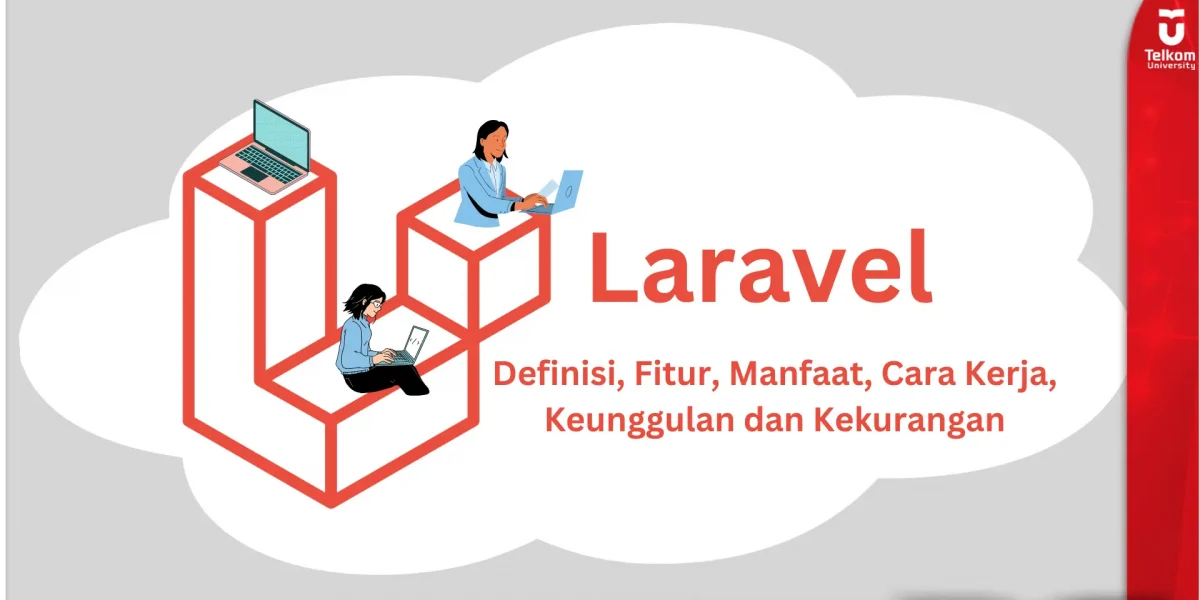Laravel: Definition, Features, Benefits, How It Works, Advantages and Disadvantages
PHP Framework is a platform that is used as a framework in building web applications using the PHP programming language In the web application development process, there are several tools that can be used to reduce the time required for web application development. This collection of tools is called a framework. In general, frameworks contain several code templates and simplify the application development process that would otherwise require creating programming code from scratch by utilizing the features provided by the framework. One of the most popular PHP frameworks is Laravel. For more information about Laravel, you can find a clearer review in the article:
Definition of Laravel
Laravel was chosen by Taylor Otwell in 2011 as a personal project with the aim of improving CodeIgniter, which at that time was a well-known framework and was widely used by application developers. After several iterations, Taylor made Laravel open source under the MIT License, making it freely available to the developer community. The Laravel framework quickly gained traction and gained a loyal following due to its syntax, features, and ease of use. An active community of developers began contributing to the development, documentation, and ecosystem of Laravel. This collaborative effort continues to solidify Laravel’s position as the leading open source PHP framework to date.

Laravel is a powerful and easy-to-understand open source PHP framework that follows the model-view-controller design pattern. Laravel reuses different existing working components to help in the development of creating web applications. Laravel also offers a set of functions that combine the basic features of PHP frameworks such as Codeigniter, Yoo and other programming languages such as Ruby on Rails. Laravel tries to take the difficulty out of development by easing common tasks that most web projects use, such as authentication, routing, sessions and caching.
Laravel aims to make the development process fun for developers without sacrificing the functionality of the application. Laravel has a very varied set of features that can improve web development opportunities. The use of laravel in web development can prevent some web attacks.
Laravel Features
Since its release, Laravel has continued to evolve with each new version bringing exciting features and making web development easier and more efficient. Here are the features of Laravel:
1. MVC Architecture
This feature is used as the most significant feature to make it more attractive for developers to improve the efficiency of web pages and applications. These built-in features can also improve the security and scalability of applications, enabling smooth operation and performance. In addition, this feature can increase efficiency and provide developers with better documentation alternatives.
2. Dynamic Templates
This feature is the most interesting of Laravel web development, namely the existence of lightweight templates. Developers can utilize these dynamic templates to design satisfying layouts, integrate CSS smoothly and incorporate powerful JavaScript frameworks.
With this feature, developers can produce web pages and web applications that consistently deliver the desired results.
3. Object Relation Mapping (ORM)
This feature has a simple but important function in implementing PHP active code. ORM encourages developers to write database queries quickly and easily using PHP syntax. Laravel performs ORM faster and smoother than other PHP frameworks. This makes it easy for developers to build robust and scalable web pages and online applications. This feature is also very beneficial for developers due to faster development time
4. Modular Library
Laravel incorporates object-oriented libraries that are exclusive to this framework and not found in other PHP frameworks. It offers a wide range of features and functions that are easy to use when developing web pages and actions. The number of active users, cross-site request forgery, password encryption and reset are all functions that developers can check.
5. Data Migration
The following features of Laravel can be utilized to effectively change the database structure using PHP code, as data migration from one program to another is a common requirement for developers. With this feature, developers can migrate and re-migrate databases without having to remember them thanks to Laravel’s schema builder. The entire migration process is automated allowing developers to migrate data without any hassle or worry of data loss.
6. Integrated Tools
By using this feature, developers can avoid time-consuming programming processes. This feature aims to simplify difficult tasks, such as maintaining multiple database systems and managing database migrations. Through the command line, developers can also create MVC files and manage asset configurations as desired.
7. Unit Testing
Laravel features testing and is capable of running multiple unit tests, ensuring that all updates are implemented correctly without changing the code, PHP unit and automated testing is supported by Laravel.
Benefits of Laravel
The main goal of Laravel is to simplify the development process and make it more efficient and enjoyable for developers. This is achieved by offering a highly functional and well-designed syntax, supported by various web development tools. Laravel’s philosophy revolves around the following key principles:
Here are some of the benefits that Laraval provides:
1. Expressive Syntax
Laravel aims to provide a simple, clean and expressive syntax that allows developers to write readable, maintainable and efficient code.
2. Modularity
The Laravel framework is designed with a modular architecture, allowing developers to use certain components independently or together to build applications of different complexities.
3. Developer Experience
Laravel prioritizes the developer experience by providing a friendly community, detailed documentation and built-in tools that increase productivity and ease of development.
4. Security
Laravel has a focus on security and includes features such as CSRF protection, SQL injection prevention and secure authentication and authorization mechanisms.
5. Exstensibility
Developers can extend the core functionality of Laravel by creating custom packages and integrating third-party libraries.
How Laravel Works
There are several stages of work that website developers must go through to apply Laravel so that it can function on a website display.. Here is how Laravel should work, namely:
Laravel follows the following workflow:
- Modeling and Controllers:
- Configuration Migration as a Table structure
- Perform migration to create a database
- Configure the person model to be editable
- Create an index view as a base view
- Add route for URL navigation
- Configure read to display data
- Configure create to create data
- Perform configuration updates to change data
- Configure delete to delete data
In order to enable laravale, it is important to note that developers must first install the Xampp and Composer applications.
Laravel Advantages
Since its launch in 2011, Laravel has become one of the most popular libraries. Many developers have fallen in love with its ease and excellence but still Laravel is still not semperna and there are still some shortcomings in its implementation, here are some of the advantages and disadvantages of Laravel
There are 5 advantages of Laravel that can be felt by developers when developing web-based applications, as follows:
- Simple coding
It has been felt by many developers who use Laravel that coding is usually one of the most complicated things, but Laravel makes some tasks easier, this is because Laravel has an extensive library that contains features that have pre-programmed functionality.
- Scalability
Laravel is one of the scalable frameworks that makes it easy for developers to use it for small and medium-sized web applications
- Safe:
Laravel has a built-in secure access control system and also provides a responsibility mechanism that allows developers to handle bugs or issues easily, in addition, this framework allows developers to store passwords in an encrypted format so that the web gets extra protection.
- Easy Data Migration
Data migration is much simpler when using Laravel, as data migration is done in less time than usual.
- Easy to Learn
Laravel is one of the easier frameworks to access and Laravel includes PHP screencasts that are easy to understand.
Among the several advantages that Laravel has, there are several disadvantages that programmers must anticipate if they want to use this framework. Here are some of the shortcomings that laravel has:
- Slow Performance :Laravel’s performance is slower compared to some other frameworks, especially when managing high demand.
- Too Fast Updates: Laravel has regular updates, but this will make it difficult for software that does not match the required specifications.
- Composer Dependency :With this dependency, Laravel users need to be aware of and familiar with the composer.
- Heavy size :This is because Laravel creates more assets in running the application
Baca Juga Framework: Definition, Functions, How it Works, Types, Types.
Baca Juga Codeigniter: Definition, Features, Benefits, How it Works, Advantages and Disadvantages
Baca Juga ReactJS: Definition, Features, Benefits, How it Works and Advantages

